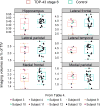Updated TDP-43 in Alzheimer's disease staging scheme
- PMID: 26810071
- PMCID: PMC5946692
- DOI: 10.1007/s00401-016-1537-1
Updated TDP-43 in Alzheimer's disease staging scheme
Abstract
In this study, we update the TDP-43 in Alzheimer's disease staging scheme by assessing the topography of TDP-43 in 193 cases of Alzheimer's disease, in 14 different brain regions (eight previously described plus six newly reported) and use conditional probability to model the spread of TDP-43 across the 14 brain regions. We show that in addition to the eight original regions we previously reported [amygdala, entorhinal cortex, subiculum, dentate gyrus of the hippocampus, occipitotemporal cortex, inferior temporal cortex, middle frontal cortex and basal ganglia (putamen/globus pallidum)] that TDP-43 is also deposited in the insular cortex, ventral striatum, basal forebrain, substantia nigra, midbrain tectum, and the inferior olive of the medulla oblongata, in Alzheimer's disease. The conditional probability analysis produced six significantly different stages (P < 0.01), and suggests that TDP-43 deposition begins in the amygdala (stage 1), then moves to entorhinal cortex and subiculum (stage 2); to the dentate gyrus of the hippocampus and occipitotemporal cortex (stage 3); insular cortex, ventral striatum, basal forebrain and inferior temporal cortex (stage 4); substantia nigra, inferior olive and midbrain tectum (stage 5); and finally to basal ganglia and middle frontal cortex (stage 6). This updated staging scheme is superior to our previous staging scheme, classifying 100% of the cases (versus 94% in the old scheme), based on criteria provided, and shows clinical significance with some regions and with increasing stage. We discuss the relevance of the updated staging scheme, as well as its impact on the prion-like hypothesis of protein spread in neurodegenerative disease. We also address the issue of whether frontotemporal lobar degeneration with TDP-43 could be the primary pathology in stage 6.
Keywords: Alzheimer’s disease; Brainstem; Insular cortex; Limbic; Staging; TDP-43.
Figures







Similar articles
-
Staging TDP-43 pathology in Alzheimer's disease.Acta Neuropathol. 2014 Mar;127(3):441-50. doi: 10.1007/s00401-013-1211-9. Epub 2013 Nov 16. Acta Neuropathol. 2014. PMID: 24240737 Free PMC article.
-
TDP-43 pathology in anterior temporal pole cortex in aging and Alzheimer's disease.Acta Neuropathol Commun. 2018 May 1;6(1):33. doi: 10.1186/s40478-018-0531-3. Acta Neuropathol Commun. 2018. PMID: 29716643 Free PMC article.
-
Pathological, imaging and genetic characteristics support the existence of distinct TDP-43 types in non-FTLD brains.Acta Neuropathol. 2019 Feb;137(2):227-238. doi: 10.1007/s00401-018-1951-7. Epub 2019 Jan 2. Acta Neuropathol. 2019. PMID: 30604226 Free PMC article.
-
Protein contributions to brain atrophy acceleration in Alzheimer's disease and primary age-related tauopathy.Brain. 2020 Dec 5;143(11):3463-3476. doi: 10.1093/brain/awaa299. Brain. 2020. PMID: 33150361 Free PMC article.
-
Coexistence of TDP-43 and tau pathology in neurodegeneration with brain iron accumulation type 1 (NBIA-1, formerly Hallervorden-Spatz syndrome).Neuropathology. 2011 Oct;31(5):531-9. doi: 10.1111/j.1440-1789.2010.01186.x. Epub 2011 Jan 30. Neuropathology. 2011. PMID: 21276079 Review.
Cited by
-
Resistance of Basal Forebrain Cholinergic Neurons to TDP-43 Proteinopathy in Primary Progressive Aphasia.J Neuropathol Exp Neurol. 2022 Oct 18;81(11):910-919. doi: 10.1093/jnen/nlac079. J Neuropathol Exp Neurol. 2022. PMID: 36111818 Free PMC article.
-
Liquid-liquid phase separation in Alzheimer's disease.J Mol Med (Berl). 2024 Feb;102(2):167-181. doi: 10.1007/s00109-023-02407-3. Epub 2024 Jan 2. J Mol Med (Berl). 2024. PMID: 38167731 Review.
-
An Autopsy-Proven Case of Limbic-Predominant Age-Related TDP-43 Encephalopathy.Yonsei Med J. 2020 Aug;61(8):731-735. doi: 10.3349/ymj.2020.61.8.731. Yonsei Med J. 2020. PMID: 32734738 Free PMC article.
-
A limbic-predominant amnestic neurodegenerative syndrome associated with TDP-43 pathology.medRxiv [Preprint]. 2023 Nov 20:2023.11.19.23298314. doi: 10.1101/2023.11.19.23298314. medRxiv. 2023. Update in: Brain Commun. 2024 Jul 17;6(4):fcae183. doi: 10.1093/braincomms/fcae183. PMID: 38045300 Free PMC article. Updated. Preprint.
-
Limbic-predominant age-related TDP-43 encephalopathy, ADNC pathology, and cognitive decline in aging.Neurology. 2020 Oct 6;95(14):e1951-e1962. doi: 10.1212/WNL.0000000000010454. Epub 2020 Aug 4. Neurology. 2020. PMID: 32753441 Free PMC article.
References
-
- A R. L'examen clinique en psychologie. Presses Universitaires de France; City: 1964.
Publication types
MeSH terms
Substances
Grants and funding
LinkOut - more resources
Full Text Sources
Other Literature Sources
Medical

